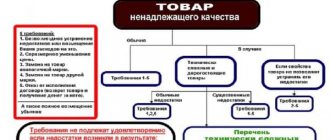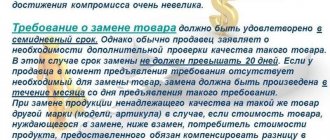The issue of returning household appliances to the seller has become quite acute lately. The main reasons here are a large assortment of electrical household goods, which complicates the right choice, and sometimes the low quality of the products offered. The low legal literacy of our fellow citizens, who are poorly aware of their rights, also plays a negative role. Let's take a closer look at all the nuances of this procedure: returning household appliances within 14 days, consumer rights and which authorities should be contacted if they are violated.
About returning household appliances
The procedure for returning household appliances is largely determined by the category to which it belongs.
All devices are divided into:
- Technically complex devices.
- Simple design, from a technical point of view.
List of goods related to household appliances
First of all, you should decide what constitutes complex household appliances? The list of technically complex household devices is given in government decree No. 924.
This includes:
- Refrigerators and freezers;
- Dishwashers;
- Washing machines and separate centrifuge dryers;
- Coffee makers;
- Food processors, electric meat grinders and electric juicers;
- Cookers, both electric and gas;
- Ovens;
- Microwave ovens;
- Vacuum cleaners;
- Water heating boilers;
- Mixers, blenders, toasters;
- Electric irons, steamers;
- Air conditioners, electric heaters and other home climate control equipment.
And this is not a complete list of devices that are officially considered technically complex devices.
Which products are technically complex?
According to the list approved by Decree of the Government of the Russian Federation No. 924 dated November 10, 2011, structurally complex goods include:
| Devices equipped with an electric motor (ICE - internal combustion engine) |
|
| |
| |
| |
| |
| Devices with at least 2 functions |
|
| Personal use equipment |
|
| Devices with digital control |
|
| |
| |
| |
| Household appliances with microprocessor automation and (or) electric motor |
|
The legislative framework
The return of purchases that are not related to food products is prescribed in Article 25 of Federal Law No. 2300-1, which regulates the protection of consumer rights of the population.
Expert opinion
Anna Fedorova
Lawyer-consultant
Ask me a question
According to it, you can return a purchased product that does not have defects within two weeks to a regular store, and within a week to an online seller. The reason for a return may be the most common reason: the style or color of the item is not what was expected, the size did not fit, the technical characteristics of the device did not satisfy the buyer’s needs.
Separately, Article No. 18 prescribes the procedure for returning a purchased item if a manufacturing defect is discovered.
In this situation, the buyer has the right to contact the seller with the requirement :
- Replacement with a similar product
- Refund.
- Recalculation of cost taking into account the identified defect.
- Carrying out repairs at a service center.
The time allotted for contacting the seller in such cases is equal to the warranty period established by the manufacturer for the purchased item.
Buyer's rights
If defects are detected in a technically complex product, the rights of the consumer are defined in Article 18 of the Law “On the Protection of Consumer Rights”.
- If deficiencies are identified, the buyer can return a low-quality product with a complex internal structure, demand a refund of the amount paid, or exchange it for a quality product within 2 weeks inclusive of the purchase of this product.
- Upon completion of the 14-day period after the purchase of a structurally complex purchase, the consumer may make the above claims only if the defect is considered significant.
Consumer rights and return of equipment within 14 days
The consumer has the right to return any product that is not included in the list of so-called “non-returnable” items within two weeks from the date of purchase.
But a number of special conditions :
- The purchase should not lose its presentation;
- All warranty seals and seals, factory labels must be preserved;
- The presence of packaging, even if opened.
Until recently, one of the mandatory conditions for returning equipment to a store was that the buyer had a receipt. But, with the introduction of adjustments to the consumer protection law, this requirement was canceled.
If a receipt is lost, you can now present other evidence as proof of a purchase in a given store: video recordings, witness statements.
To return a product, it does not matter how you paid for it - cash, card, or credit.
In general terms, the return procedure looks like this:
- The returned item is delivered back to the seller before the expiration of the two-week period.
- A statement is written with a requirement to accept the product back, or exchange it for a similar one, but of a different color (size, configuration). If there is a difference in price, an additional payment by the buyer, or a refund of part of the money by the seller, is allowed.
- The seller officially issues the return of the purchased product. Refunds are made either directly at the cash desk in cash or by transfer to the client’s bank card.
Court decisions
Problems with a travel agency
Let's go to peace: How diplomatic successes saved your wallet
How to win a lawsuit against a dentist
The case of an unprovided service, or How to return the money paid
The car dealership does not give away the car
A diet that only makes your wallet thin
Return policy for household appliances
Federal Law No. 2300-1 establishes the basic rules for returning purchased items.
The order of the procedure depends on a number of factors:
- Does this item belong to the category of technically complex devices;
- Does it have a manufacturing defect;
- How much time has passed since purchase.
Return deadlines
The rules for returning household appliances established by the Federal Law on the Protection of Consumer Rights determine the following terms :
- If there is no defect, or if there are minor defects that do not affect the operation of the device - 14 days. In this case, the day on which the purchase was made is not taken into account.
- If a manufacturing defect is discovered, a citizen has the right to demand a return or replacement of the purchase with another, throughout the entire warranty period. Significant defects include those that negatively affect the functional properties of the item.
- When warranty repair of a defective item is carried out in a specialized service, it must be completed within 1.5 months. In the future, these 45 days will be deducted from the warranty period.
Return after 15 days
After the expiration of the allotted period of 2 weeks, it will no longer be possible to return the purchased product to the store, if it does not have a significant defect.
You can only return a purchase after two weeks that has serious technical deficiencies during use. The defective item is sent for examination to specialists who identify the nature of the damage.
If it turns out that the manufacturer is at fault, the item will be exchanged or the money paid will be refunded. The client also has the right to demand free repairs or a revision of the cost, taking into account the nature of the problem.
Nuances
Unscrupulous sellers very often turn to clause 11 of Russian Government Decree No. 55, trying to prove that the goods listed on this list can never be returned.
IMPORTANT
It must be remembered that the list of technically complex products is not accepted for exchange only because of proper quality. If the product is defective, it can be returned or exchanged.
Often the seller does not want to accept a defective, structurally complex product and return the buyer’s money. In such circumstances, it is necessary to act through the courts. If his decision is positive, the seller will be charged the entire cost of the goods and a 1% penalty for 1 day of delay. In special cases, the seller may be subject to a 50% fine of the amount due to the buyer. This fine goes to the budget.
Comments Showing 0 of 0
List of complex household appliances that cannot be returned
A special category of household appliances consists of technically complex products. Its peculiarity is that it cannot be returned if no manufacturing defect is found. This provision is enshrined in Federal Law No. 2300-1, which regulates the procedure for returning purchases.
The list of such non-returnable products is contained in government decree No. 924. This list is regularly updated and currently includes 14 product categories.
Return of defective equipment
Returning equipment to the store before the expiration of the 2-week period is quite simple. You just need to return the goods to the seller and write a statement. But after 14 days from the date of purchase, you can only return a defective item. To confirm the presence of a manufacturing defect, the product is sent for diagnostic examination.
Diagnostics
The examination is carried out by specialists who have the necessary permits and licenses. As a rule, these are service center employees affiliated with the manufacturer or the seller. By inspecting the equipment, specialists determine the cause of the malfunction, and based on the results of the examination, issue their conclusion.
The period allotted by law for carrying out the procedure is 1 calendar month . Therefore, the buyer, when submitting the purchase for examination, must take a receipt with a marked date.
Expert opinion
Anna Fedorova
Lawyer-consultant
Ask me a question
If the diagnostic inspection takes longer than the established period, the client has the right to refuse the purchased equipment, demanding a refund of the money paid, or an exchange of the product for an identical one.
Return Policy
The return of equipment with serious manufacturing defects is carried out in compliance with the following principles :
- As a result of the examination, it was determined that the cause of the problem was a manufacturing defect, and not the actions of the buyer;
- The examination or warranty repairs are delayed for periods exceeding those established by law;
- A repaired device breaks down again during the warranty period for the same reason;
- The complexity of warranty repairs is such that it is more profitable to provide the client with a similar product. In this case, the initiative comes from the seller himself.
After the buyer submits a request to return the equipment, the seller is given a ten-day period to consider the issue. During this time, store representatives contact the client and announce the decision made - to take the goods back or refuse it. In case of an examination, the period for making a decision is extended by 20 days.
In case of refusal, you must take an official document from the seller, which will indicate the reason for the refusal to return. Based on this document, the consumer will subsequently be able to defend his rights in Rospotrebnadzor or in the courts.
Making a claim
The claim application submitted by the buyer when returning equipment does not have a single established template. It can be written in free form, or on the retail chain’s own letterhead. From a legal point of view, this does not matter - the main thing is that it contains up-to-date information.
The main requirements for the structure of the application are as follows:
- Buyer details: full name, contact phone number or e-mail.
- Name of the purchased household appliance: manufacturer’s brand and model.
- Date of purchase.
- The nature of the problem that interferes with the normal operation of the product.
- Request for return/exchange of purchase.
- The application is certified by the buyer’s personal signature; the date of preparation is indicated at the end of the paper.
Seller's rights
When returning a technically complex product, the seller has the right:
- Check the defect discovered by the buyer. And if it is missing or the consumer’s involvement in the product malfunction is revealed, refuse to accept the return.
- Do not accept back a product with a complex internal structure of proper quality.
- Require identification from the buyer to properly process return documents.
- If more than 14 days have passed since the transaction, determine whether the deficiency is considered significant. As a rule, simply checking the serviceability of the device is not enough; professional expertise is required. If the warranty period is valid, it is paid by the seller; if it has expired, the buyer pays.
What to do if a return is refused
If the seller refuses to accept the defective equipment back, the client has the right to complain about him to the supervisory authorities. Rospotrebnadzor or the court act in their capacity.
The complaint must be accompanied by a copy of the submitted return application, as well as a document from the seller explaining the reason for the refusal (if any). Based on the results of consideration of the appeal, Rospotrebnadzor employees order an investigation into the circumstances of the incident, and the courts initiate civil proceedings.
Drawing up a statement of claim
The claim to the judicial authorities is drawn up in accordance with the standards prescribed in Article No. 131 of the Code of Civil Procedure of the Russian Federation.
It consists of the following sections:
- The so-called “cap” is placed in the upper right part. It indicates the name of the judicial authority, details of the plaintiff and defendant, his address of residence and contact telephone number;
- Below is the main text, which outlines the essence of the problem in detail, but as concisely as possible;
- Next, the plaintiff puts forward a specific demand: exchange of the purchased product, or refund of money for it;
- At the end there is a list of supporting documents attached to the claim;
- At the bottom of the paper is the date and personal signature of the plaintiff.
An application is submitted in 2 copies to the court office, where the secretary issues the applicant a receipt for acceptance of the paper. After consideration of the claim, a day for court hearings is set, of which the citizen is notified by an official letter.
Package of documents
When filing a claim for refusal to return household appliances, a certain list of documentation :
- Photocopy of the applicant's passport.
- Copies of the claim, according to the number of participants in the trial, including the defendant and witnesses.
- An application to the store requesting a return and an official refusal (if any).
- Evidence confirming the fact of a purchase from this seller. This could be checks, witness statements, photos and videos.
- If the case is not conducted by the plaintiff himself, but by his official representative, he must have a notarized power of attorney.
Where to send
The specific court for filing a claim for the protection of consumer rights is determined in accordance with the provisions of Article No. 29 of the Code of Civil Procedure. The plaintiff has the right to independently choose whether it will be a court at his place of residence, or at the place of registration of the seller.
Jurisdiction is also by the size of claims for return:
- When the amount of the claim is less than 50 thousand rubles, then the magistrate deals with it;
- If an amount exceeding 50 thousand is demanded from the defendant, the case is considered by a district or city judge.
State duty amount
For applying to the courts, in accordance with Article No. 333 of the Tax Legislation, the applicant is charged a fee. Its size depends on the size of the claim.
| Cost of claim | State duty as a percentage of the claim amount | Minimum state duty |
| From 20 to 100 thousand rubles | 4% | 400 rubles |
| From 20 to 100 thousand | 3% | 800 rubles |
| From 100 to 200 thousand | 2% | 3200 rubles |
| From 200 thousand to a million | 1% | 5200 rubles |
| Over 1 million | 0,5% | 13200 rubles |
Trial time frame
The time limits allocated by the procedural code for trial are :
- 1 month when appealing to a district or city judge.
- 2 months when applying to a magistrate.
Expert opinion
Anna Fedorova
Lawyer-consultant
Ask me a question
In exceptional cases, they may be extended. For example, if it is necessary to conduct an independent examination regarding the nature of the malfunction of the returned household appliances.











